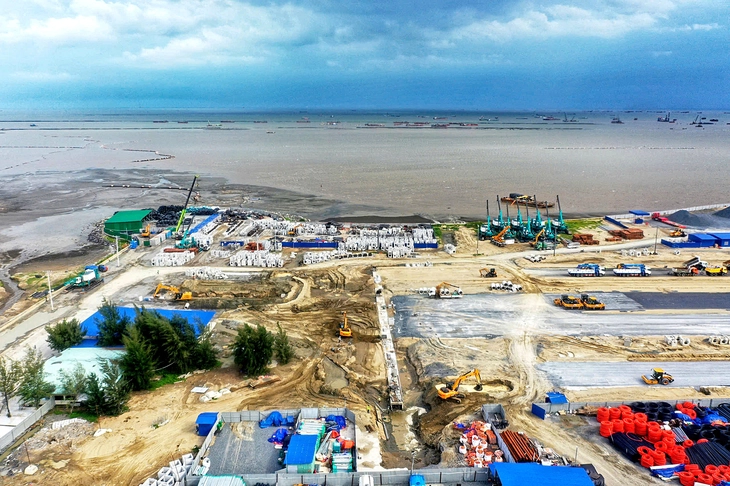
Can Gio is changing every day: in addition to the Can Gio urban area project (Can Gio commune, Ho Chi Minh City), there will be many bridge and road projects in the near future, turning this place into an infrastructure connection center - Photo: TRI DUC
Can Gio is expected to become a new infrastructure center, a gateway to the sea of Ho Chi Minh City.
Can Gio area (including 4 communes Can Gio, Binh Khanh, An Thoi Dong, Thanh An separated from the old Can Gio district) was once likened to "the sleeping princess in the forest", now being awakened. A series of large-scale projects with modern technology have been converging here in the 2025 - 2030 term, signaling a breakthrough period for Can Gio to rise up in its development journey.
The mega infrastructure projects along with the urban sea reclamation projects, when completed, will reverse the traffic flow. Tourists from Vung Tau to Can Gio for entertainment will only take about 10 minutes. People from the center of Ho Chi Minh City to Vung Tau will choose to go through Can Gio; from the Western coast to Ho Chi Minh City and Vung Tau will also go through Can Gio, instead of having to go around like now.
Architect Khuong Van Muoi (former Chairman of Ho Chi Minh City Association of Architects)
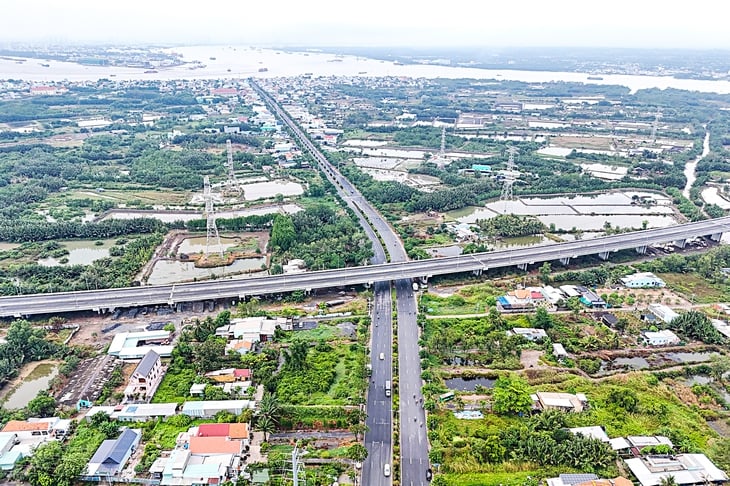
Rung Sac Road - the main traffic axis connecting Can Gio with Ho Chi Minh City's inner city - Photo: TR.PHUONG
Many super projects converge in Can Gio
The most obvious highlight in the transformation of Can Gio is the Vinhomes Green Paradise coastal tourism urban area project. With a scale of 2,870 hectares and an estimated population of about 230,000 people, this is not only an urban area but also an ecological, smart, resort, and service city that meets international standards, creating an "urban wonder on the sea" - a new symbol for the stature of Ho Chi Minh City.
Connecting to this megacity, VinSpeed High-Speed Railway Investment and Development Joint Stock Company ( Vingroup Corporation) has also researched a high-speed urban railway from the center of Ho Chi Minh City to Can Gio, 48.5km long. The investor is speeding up procedures with the goal of starting the project in 2025 and completing it in 2028.
With a speed of 350km/h, when completed, this high-speed urban railway will shorten travel time from the center to the coastal urban area to about 15 minutes, carrying 30,000 - 40,000 passengers per hour, each direction.
Most recently, in early October 2025, the Ho Chi Minh City People's Committee issued a document directing departments and branches to appraise and give comments on Vingroup's proposal to study the Can Gio - Vung Tau sea-crossing road project under the BT (build - transfer) form, reporting before October 10.
In the proposal, Vingroup said that after Ba Ria - Vung Tau merged into Ho Chi Minh City, the need for direct connection between the two coastal areas became more urgent.
This area has a strategic position for marine economy, tourism and ecological urban development, but currently transport infrastructure is still limited, mainly depending on ferries and roundabout routes.
The Can Gio - Vung Tau sea route will significantly shorten travel time between the two areas, creating a new traffic corridor connecting functional areas in the city.
At the same time, Can Gio is investing in additional road projects to break the unique situation of having to rely on Binh Khanh ferry to cross the river. Specifically, the Department of Construction recently submitted to the City People's Committee a decision on the investment policy for the intersection connecting Ben Luc - Long Thanh expressway with Rung Sac road, with a total capital of more than 2,969 billion VND.
The project is proposed to start construction in early 2026 and be completed in 2028. When this interchange is put into operation, people from the West and Southeast regions can go straight to Can Gio via Ho Chi Minh City Ring Road 3 - Ben Luc Long Thanh Expressway - Rung Sac Road to get to Can Gio faster.
Along with the above intersection, Can Gio Bridge is currently being accelerated by the City. This project worth more than 11,000 billion VND is being considered by Masterise Group Joint Stock Company and Trungnam Group and proposed for investment in the form of public-private partnership (PPP).
Regarding the direction of connecting with the world by sea, after the merger, Ho Chi Minh City plans to develop a smart port - logistics cluster at Cai Mep - Thi Vai - Can Gio following the model of a digital super port and an integrated logistics system, operating on a big data platform.
With all the favorable conditions, Ho Chi Minh City has the opportunity to become the leading maritime logistics center in Southeast Asia - a gateway directly connected to the global supply chain.
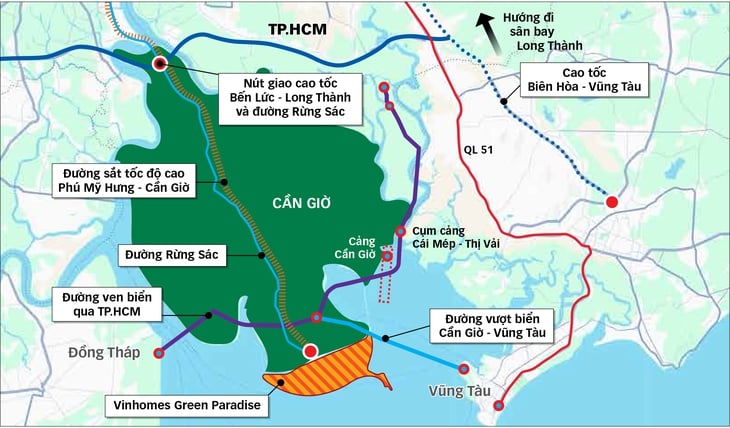
With a series of infrastructure projects to be implemented, Can Gio will be transformed from a "dead-end" land into an infrastructure center - Graphics: TAN DAT
New gateway, new center of Ho Chi Minh City
Speaking to Tuoi Tre, architect Khuong Van Muoi - former Chairman of the Ho Chi Minh City Architects Association - said that mega infrastructure projects such as sea-crossing roads, coastal roads, metro, along with urban projects reclaiming the sea will reverse the flow of tourists and residents. At that time, it will only take about 10 minutes to go from Vung Tau to Can Gio and tourists and residents will go from Vung Tau to Can Gio for entertainment.
Or from the center of Ho Chi Minh City to Vung Tau, you will choose the route through Can Gio, from the western coast to Ho Chi Minh City and Vung Tau also go through Can Gio, instead of taking the current roundabout routes.
According to him, Can Gio is considered a "dead end", for many decades it has not developed commensurate with its great potential. Meanwhile, Ba Ria - Vung Tau has the advantage of deep-water seaports and sea tourism, but still faces limitations in regional connectivity and value chain development. After the merger, these two areas complement each other perfectly, creating a new development pole with both a natural ecosystem and urban infrastructure - a large-scale tourist urban area.
Mr. Muoi believes that investing in the Can Gio - Vung Tau sea route along with the coastal route of Ho Chi Minh City connecting with the Mekong Delta will be a big boost to open up new development space. In addition, the authorities also need to consider connecting the railway or metro from Vung Tau through Can Gio or connecting with the Western provinces through Dong Thap and Tay Ninh.
"Every movement from Can Gio coastal urban area, to metro, seaport to sea-crossing road is a driving force for the development of the new Ho Chi Minh City. Because wherever the traffic infrastructure develops smoothly, the economy will have a strong breakthrough. The world does not wait for us, so the city needs to accelerate very quickly to keep up and move forward," said Mr. Muoi.
Analyzing the infrastructure connection, engineer Vu Duc Thang - a traffic planning and design expert - said that currently all the goods flows from the West are converging to My Tho - Dong Thap (old Tien Giang). The roads to relieve resources in My Tho are all going in a large arc to Ben Luc - up to Bien Hoa - to the North. If there is a shortcut along the coast, it will reduce a lot of time and costs.
From Can Gio, looking across Ganh Rai Bay, Vung Tau appears right before your eyes - the distance seems close but is far because there is no direct road connection. Meanwhile, the Can Gio sea encroachment urban area project is under construction, along with the new development orientation of Ho Chi Minh City after the merger, which will strongly promote the need for travel and trade.
"That requires the early implementation of strategic and large-scale traffic projects such as the southern coastal road, including the Can Gio - Vung Tau sea-crossing bridge, to create momentum for the entire southern coastal urban axis.
From here, this route will connect with the central coastal route, extending straight to the North, forming a seamless North-South coastal corridor, paving the way for a long-term development vision of the country," Mr. Thang proposed.
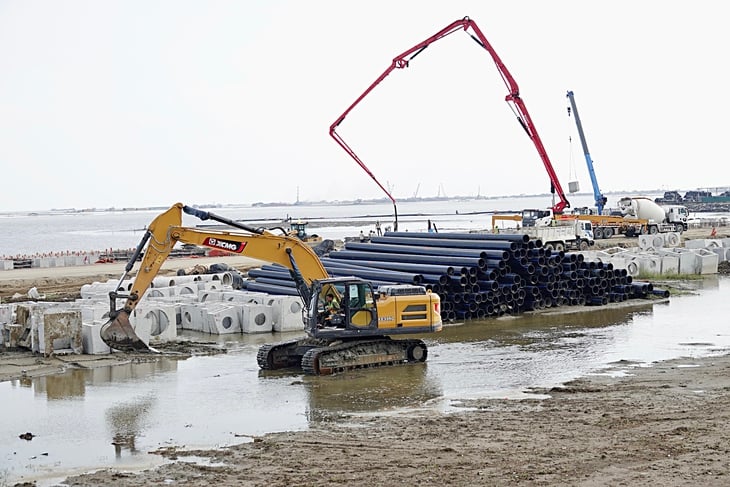
Construction of Can Gio coastal urban area (Can Gio commune, Ho Chi Minh City) - Photo: TTD
50 years of opening the road to Can Gio
After the war, most of Can Gio forest was devastated, the land was dry and polluted. 50 years from the days of being just a salty swamp, with burnt trees, Can Gio has now become a world biosphere reserve, receiving the attention and protection of the whole world.
Rung Sac Road is the only road through the forest, leading to Can Gio beach. Previously, this road was just a small, narrow dirt road, enough for one vehicle to pass through. Rung Sac Road was first upgraded in 1985 from a muddy dirt road to a gravel and stone road. The road continued to be repaired and upgraded many years later to become the 6-lane Rung Sac Road as it is today.
After more than 50 years, the road to Can Gio is facing a turning point, connected in many directions from the high-speed railway, Can Gio bridge, the intersection of Rung Sac road with the highway, the sea route and the international transit port... to become a gateway for regional and world trade.
Ho Chi Minh City voters want a road connecting Can Gio - Vung Tau soon
Before the National Assembly session, voters in Ho Chi Minh City proposed to invest in developing Cai Mep - Thi Vai port into an international transit port. At the same time, build a bridge connecting Can Gio - Vung Tau, a high-speed railway connecting Ho Chi Minh City - Ba Ria - Binh Duong to promote the strength of traffic connection to serve import-export and logistics.
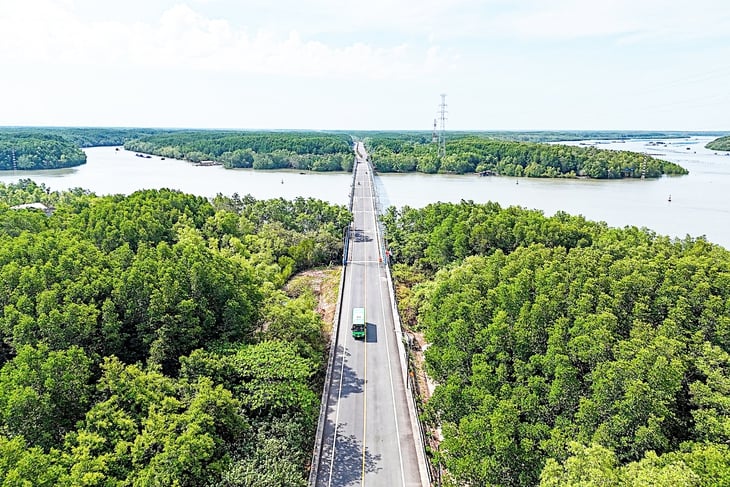
Infrastructure projects will be invested in, breaking the monopoly of Rung Sac road, helping Can Gio transform strongly in the urban coastal space development strategy of Ho Chi Minh City - Photo: CHAU TUAN
Integrated infrastructure further promotes strengths
The Ministry of Construction has just sent a document to the Ho Chi Minh City National Assembly Delegation responding to the recommendations of Ho Chi Minh City voters sent after the 9th session of the 15th National Assembly regarding the Cai Mep - Thi Vai port cluster projects, the Can Gio - Vung Tau sea bridge...
Regarding the proposal to soon invest in developing Cai Mep - Thi Vai port into an international transit port, according to the Ministry of Construction, Cai Mep port area (including Cai Mep Ha and Cai Mep Ha downstream ports) is planned as an international gateway and transit port. The port has a berth for container ships from 6,000 - 24,000 TEU or larger when qualified; general cargo ships, liquid/gas cargo ships up to 150,000 tons or larger with reduced load suitable to the conditions of exploiting the maritime route.
To develop Cai Mep port area into an international transit port, the Ministry of Construction supports the need to soon invest and put into operation Cai Mep Ha and Cai Mep Ha downstream ports according to the approved detailed seaport planning roadmap.
The Ministry of Construction said that the Ministry of Finance and Ho Chi Minh City are currently evaluating the investment proposal for the Cai Mep Ha and Cai Mep Ha downstream port projects to approve and submit to the competent authority for approval of the investment policy. The Ministry of Construction has also provided written comments on the evaluation.
Regarding the construction of the Can Gio - Vung Tau connecting road, according to the Ministry of Construction, this project is within the scope of Ho Chi Minh City (new) after the merger. The Ministry requested the Ho Chi Minh City National Assembly Delegation to consult with the Ho Chi Minh City People's Committee to study and update the Can Gio - Vung Tau connecting bridge in the city's planning after the merger and preside over the organization of investment implementation according to its authority.
Scale of coastal road through Ho Chi Minh City
According to the plan, the Southern coastal route is an important traffic axis connecting Ho Chi Minh City with the Mekong Delta, with a total length of 941km. In the Ho Chi Minh City planning for the period 2021 - 2030, with a vision to 2050, the coastal route through Ho Chi Minh City has a starting point connecting the coastal road of Tien Giang province at National Highway 50 (now Dong Thap province). The total length of the route is about 45.5km (including 10.5km through Dong Nai province) with 8 lanes. In the immediate future, phase 1 proposes to invest in 2 parallel roads, each side has 2 lanes.
Previously, the Ho Chi Minh City Department of Construction coordinated with the Transport Design Consulting Corporation to conduct a preliminary study of 3 investment options for the coastal route through Ho Chi Minh City. Option 1: when investing in the main route on the above scale, phase 1 will have a preliminary total investment of about 31,556 billion VND, phase 2 (completing 8 lanes) will need an additional 6,400 billion VND.
Option 2: invest in the main route and the branch connecting to the Can Gio - Vung Tau sea bridge (10km). The total investment for both phases is 62,231 billion VND and will shorten the distance by about 40km compared to the plan. Option 3: invest in the main route and the road to Cai Mep port with a total investment of 42,275 billion VND for both phases. When implementing this option, the journey along this route will be shortened by about 32km compared to the plan.
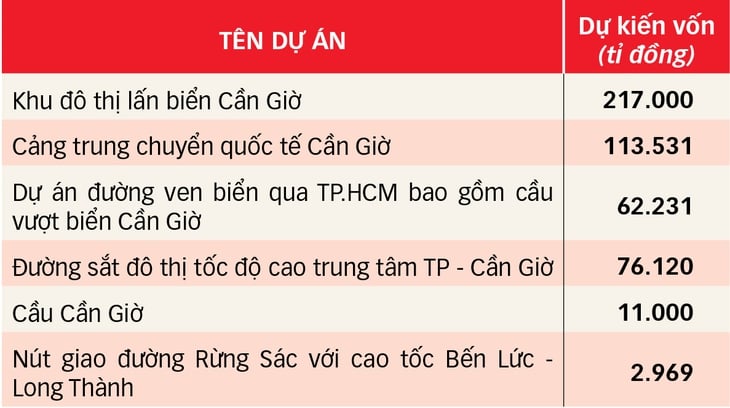
Is it difficult to build a road across the sea from Can Gio to Vung Tau?
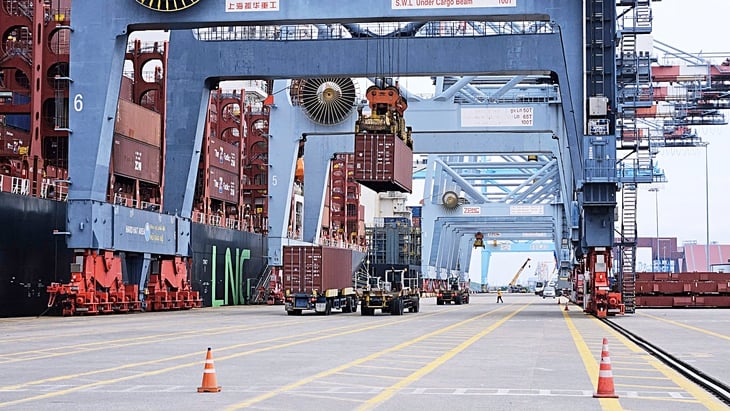
Cai Mep - Can Gio seaport cluster will become one of the strong seaport centers of Vietnam and the world - Photo: NG.NAM
This question was raised by many people when Vingroup proposed to study the sea route from Can Gio to Vung Tau and the Ho Chi Minh City People's Committee directed departments to review and advise before October 10.
Engineer Vu Duc Thang affirmed that Vietnam has now mastered many modern construction technologies such as tunneling through mountains, building bridges across valleys and bays. The capacity is ready, just waiting for large-scale projects.
In fact, a large-scale and highly complex project like the Can Gio sea encroachment project can be done, so building an overpass or a sea tunnel is completely within the reach of domestic contractors and engineers.
According to architect Khuong Van Muoi, the coastline of more than 3,260km is an advantage that not every country has. However, only when investing in forming a "silk strip" of coastal roads connecting urban areas, tourist areas and economic zones together can its full value be brought into play. It is not only a story of transportation, but also a new driving force for the country's development on its journey to the open sea.
"International experience shows that in areas with large river and maritime routes, where large tonnage ships are located, countries often choose to invest in swing bridges, sea tunnels or high-clearance sea bridges. Technically, the implementation of such projects is no longer an obstacle. The important issue is to choose the optimal solution, ensuring both technical and economic efficiency," said Mr. Muoi.
Sharing the same view, Dr. Vo Kim Cuong - former Deputy Chief Architect of Ho Chi Minh City - emphasized that, in the current context, technology is no longer a barrier but the key factor lies in the capital problem. Therefore, when there is an investor willing to invest in the Can Gio - Vung Tau sea bridge with private capital, Ho Chi Minh City needs to proactively create the most favorable conditions, shorten procedures and speed up the implementation progress.
************
>> Next: What to do to promote the convergence strength of Can Gio infrastructure?
Back to topic
DUC PHU
Source: https://tuoitre.vn/can-gio-tu-doc-dao-thanh-trung-tam-ha-tang-20251007083938911.htm





![[Photo] Prime Minister Pham Minh Chinh chairs the 16th meeting of the National Steering Committee on combating illegal fishing.](https://vphoto.vietnam.vn/thumb/1200x675/vietnam/resource/IMAGE/2025/10/07/1759848378556_dsc-9253-jpg.webp)



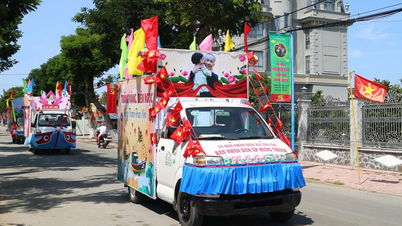


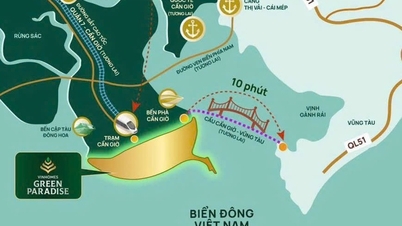
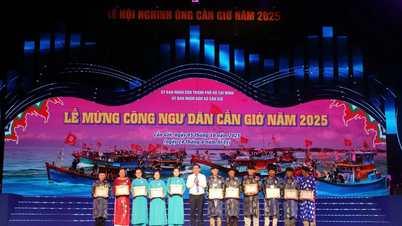

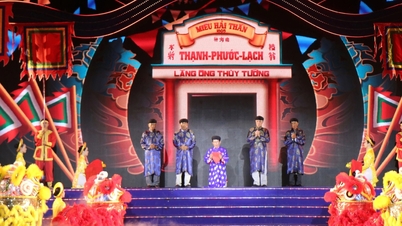

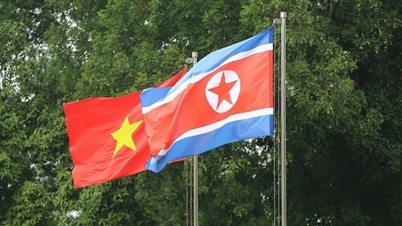



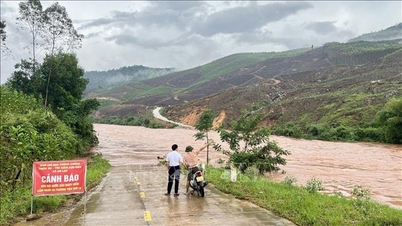












![[Photo] Super harvest moon shines brightly on Mid-Autumn Festival night around the world](https://vphoto.vietnam.vn/thumb/1200x675/vietnam/resource/IMAGE/2025/10/07/1759816565798_1759814567021-jpg.webp)





















































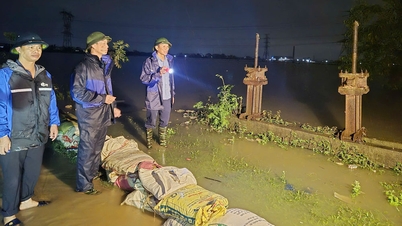














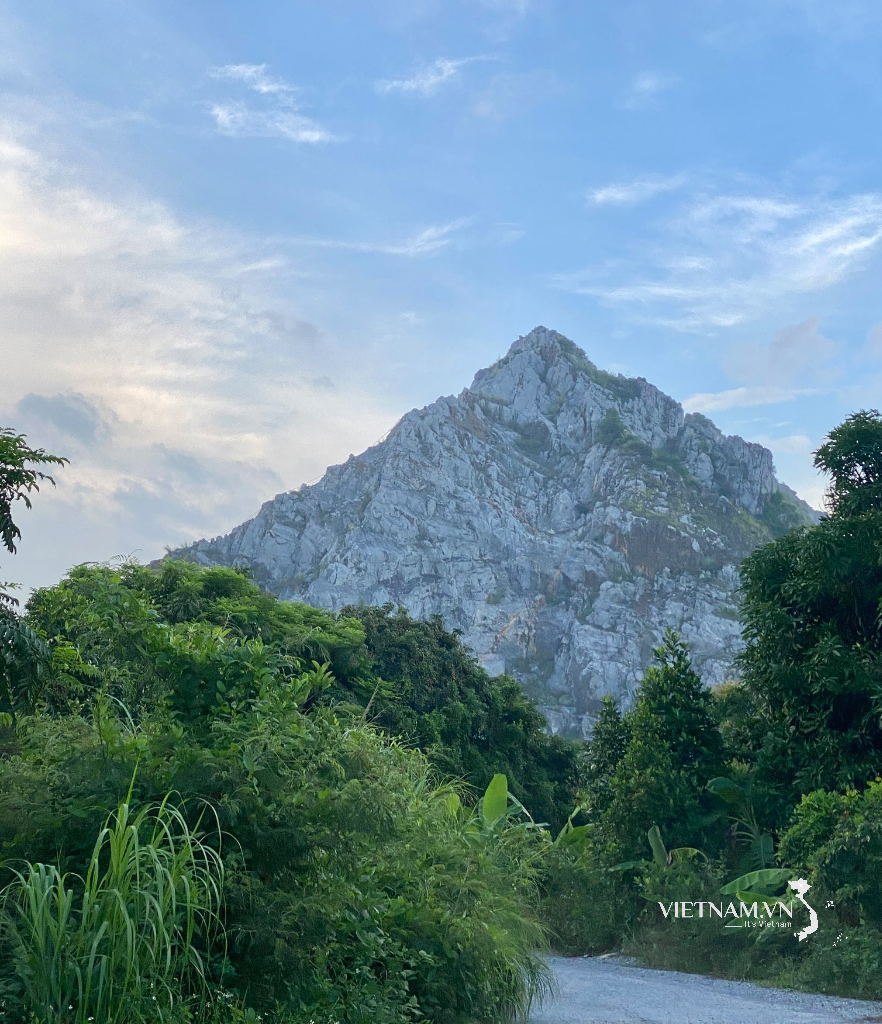
Comment (0)